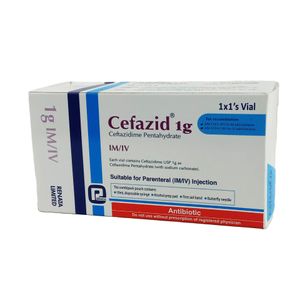Uses
Ceftazidime Injection is indicated for the treatment of patients with infections caused by susceptible strains of the designated organisms in the following diseases:Lower Respiratory Tract Infections, including pneumonia, caused by Pseudomonas aeruginosa and other Pseudomonas ... Read more
Dosage
The usual adult dosage is 1 gram administered intravenously or intramuscularly every 8 to 12 hours. The dosage and route should be determined by the susceptibility of the causative organisms, the severity of infection and the condition, and renal function of the patient.Ceftazidime is to be used by the parenteral route, the dosage depending upon the severity, sensitivity & type of infections and the age, weight & renal function of the patient. Adults: The adult dosage range for ceftazidime is 1 to 6 gm per day 8 or 12 hourly (IM/IV) in the majority of infections, 1 gm 8 hourly or 2 gm 12 hourly should be given.
In urinary tract infections and many less serious infections: 500 mg or 1 gm 12 hourly is usually adequate.
In severe infections, especially immunocompromised patients, including those with neutropenia: 2 gm 8 or 12 hourly should be administered. When used as a prophylactic agent in prostatic surgery 1 gm should be given at the induction of anesthesia. A second dose should be considered at the time of catheter removal.
Elderly: In view of the reduced clearance of Ceftazidime in acutely ill elderly patients, the daily dosage should not normally exceed 3 gm, especially in those over 80 years of age.
Cystic fibrosis: In fibrocystic adults with normal renal function who have pseudomonal lung infections, high doses of 100 to 150 mg/kg/day as three divided doses should be used.
Infants and Children: The usual dosage range for children aged over two months is 30 to 100 mg/kg/day, given as two or three divided doses. Doses up to 150 mg/kg/day (maximum 6 gm daily) in three divided doses may be given to infected immunocompromised or fibrocystic children or children with meningitis.Neonates and Children up to 2 months of age: The usual dosage range is 25 to 60 mg/kg/day as two divided doses.
Ceftazidime may be given intravenously or by deep IM injection into a large muscle mass such as the upper outer quadrant of the gluteus maximus or lateral proof of the thigh. Intra-arterial administration should be avoided. For IV/IM administration, Ceftazidime should be reconstituted with the supplied Sterile Water for Injection.
Side Effects
The most common side-effects are local reactions following IV injection and allergic and gastrointestinal reactions. Hypersensitivity reactions are pruritus, rash, and fever. Angioedema and anaphylaxis have been reported very rarely. Gastrointestinal symptoms are diarrhea, nausea, vomiting, and abdominal pain. Central nervous system reactions included headache, dizziness, and paresthesia.
See simplified version
Cefazid 250 mg/vial IM/IV Injection also
Cefazid 250 mg/vial IM/IV Injection in bangla
Precaution
The total daily dosage should be reduced when Ceftazidime is administered to patients with renal insufficiency. Ceftazidime should be prescribed with caution in individuals with a history of gastrointestinal disease, particularly colitis.
Pregnancy & Breastfeeding use
Pregnancy: No adequate and well-controlled studies in pregnant women have been conducted with Ceftazidime. Because animal reproduction studies are not always predictive of human response this drug should be used during pregnancy only if clearly needed.Lactation: Ceftazidime is excreted in human milk in low concentrations. Because many drugs are excreted in human milk and because the safety of the component of the injections in nursing infants has not been established, a decision should be made whether to discontinue nursing or to discontinue the drug, taking into account the importance of the drug to the mother.
Contraindication
Ceftazidime is contraindicated in patients who have shown hypersensitivity to Ceftazidime or the cephalosporin group of antibiotics.
Special Warning
Impaired Renal Function: Ceftazidime is excreted by the kidneys, almost exclusively by glomerular filtration. Therefore, in patients with impaired renal function (glomerular filtration rate <50 mL/min), it is recommended that the dosage of ceftazidime be reduced to compensate for its slower excretion. In patients with suspected renal insufficiency, an initial loading dose of 1 gram of Ceftazidime may be given. An estimate of GFR should be made to determine the appropriate maintenance dosage.Dosage in peritoneal dialysis: Ceftazidime may also be used in peritoneal dialysis and continuous ambulatory peritoneal dialysis (CAPD). As well as using Ceftazidime intravenously, it can be incorporated into the dialysis fluid (usually 125 to 250 mg for 2L of dialysis fluid).Impaired Hepatic Function: No adjustment in dosage is required for patients with hepatic dysfunction.
Acute Overdose
Ceftazidime overdosage has occurred in patients with renal failure. Reactions have included seizure activity, encephalopathy, asterixis, neuromuscular excitability, and coma. Patients who receive an acute overdosage should be carefully observed and given supportive treatment.
Storage Condition
Store below 25°C, protected from light and moisture. Reconstituted solutions are stable for up to 24 h if stored between 2°-8°C.
Innovators Monograph
*** Taking medicines without doctor's advice can cause long-term problems.




